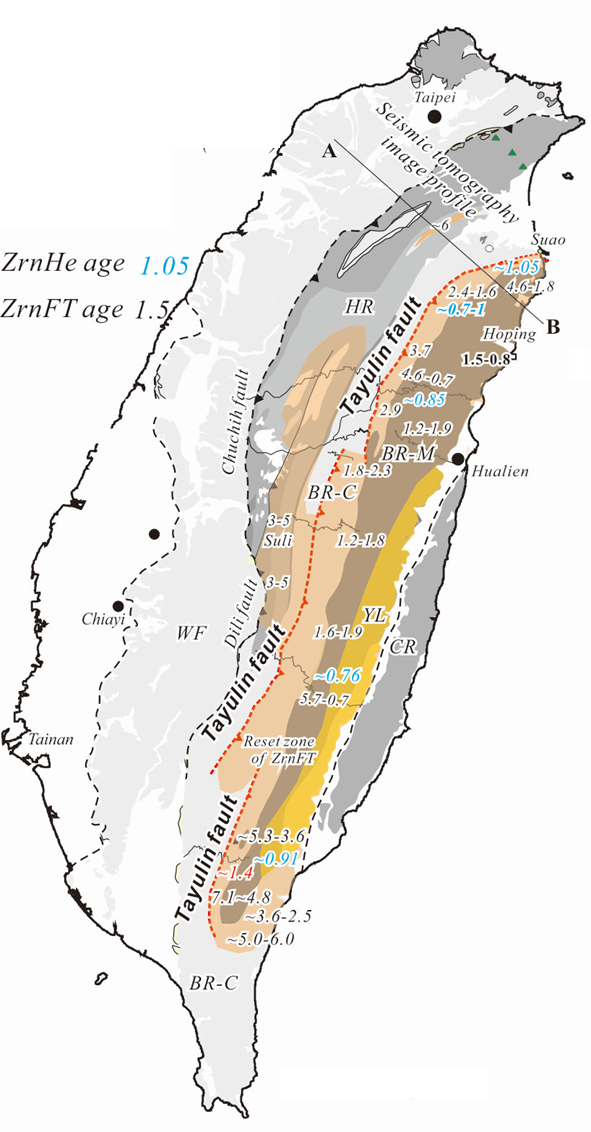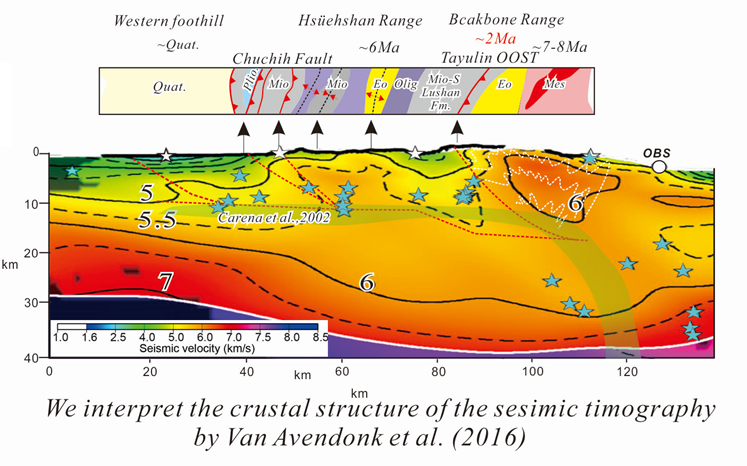TEC通訊 |
上一頁 |
首頁 |
下一頁




| ||
大禹嶺脫序斷層 - 中央山脈增厚與快速剝蝕的主要機制李元希 國立中正大學地球環境科學系doi: 10.30067/TECNL.202212_(38).0002 中央山脈東翼其抬升剝蝕速率高達每年3–6 mm/yr,此速率每百萬年可將岩層抬升3–6000公尺,此快速的抬升與剝蝕速率導致中央山東翼有極高的地溫梯度,因此有許多溫泉及地熱資源。那中央山脈快速抬升的機制為何? 許多研究認為中央山脈東側快速抬升須利用底侵(underplating)機制,將地層快速抬升(Barr and Dahlen, 1989; Fuller et al., 2006; Simoes et al., 2007; Malavieille, 2010; Malavieille et al., 2021),Malavieille等人在沙箱模型中發現中央山脈深部存在雙層斷層構造(duplex structure),此構造可以讓原先位於下盤物質進入斷層上盤並預測中央山脈無大規模逆斷層發育,上盤地層不斷被堆疊並快速抬升,發育逆斷層塊體疊加的似背斜構造。 但許多研究顯示中央山脈有許多逆斷層發育,此與underplating模型預測並不相同。但中央山脈露頭並不連續,即使發現斷層,但斷層落差有多大?有多重要?常不易評估。如何量化斷層位移量與重要性?試想若斷層位移量夠大,則斷層兩側岩層變質度必有明顯變化,且將切過不同的熱定年系統。因此我們結合既有的變質溫度並整合既有及新的熱定年資料,分析斷層可能通過位置及斷層上盤剝蝕速率,發現此斷層發育於中央山脈分水嶺西側,由北向南可分為三個區段,總長至少270公里(圖一),斷層在2Ma之後加速活動,上盤剝速速率約3–6 mm/yr速率,由於此時雪山山脈構造在6Ma開始發育,但此斷層在2Ma後仍持續活動,因此我們命名為大禹嶺脫序斷層(圖一、二)。 此斷層亦可在地震層析層相(seismic tomography image)中觀察到,Van Avendonk et al. (2016)利用地震層析層相分析台灣造山帶北段的深部構造,此剖面有極佳解析力,我們重新詮釋此剖面並與地表地質比較,圖二中可見此剖面的構造與地表地質高度吻合,如雪山山脈的背斜、中央山脈東翼東傾的高速層與低速層的相接壤,與逆斷層型態近似,且此位置與脫序斷層位置相同(圖二),剖面中可見大禹嶺脫序斷層可以延伸至地殼深部至滑脫面上,在斷層活動之時亦伴隨褶皺與韌性變形作用,因此我們認為大禹嶺脫序斷層及其伴隨的韌性變形為中央山脈快速抬升主要機制。
參考文獻Barr, T. D., & Dahlen, F. A. (1989). Brittle frictional mountain building: 2. Thermal structure and heat budget. Journal of Geophysical Research: Solid Earth, 94(B4), 3923–3947. https://doi.org/10.1029/jb094ib04p03923 Fuller, C. W., Willett, S. D., Fisher, D., & Lu, C. Y. (2006). A thermomechanical wedge model of Taiwan constrained by fission-track thermochronometry. Tectonophysics, 425(1–4), 1–24. https://doi.org/10.1016/j.tecto.2006.05.018 Lee, Y.-H., Byrne, T. B., Lo, W., Wang, S.-J., Tsao, S.-J., Chen, C.-H., Yu, H.-C., Tan, X., van Soest, M., Hodges, K., Mesalles, L., Robinson, H., & Fosdick, J. C. (2022). Out of sequence faulting in the backbone range, Taiwan: Implications for thickening and exhumation processes. Earth and Planetary Science Letters, 594, 117711. https://doi.org/10.1016/j.epsl.2022.117711 Malavieille, J. (2010). Impact of erosion, sedimentation, and structural heritage on the structure and kinematics of orogenic wedges: Analog models and case studies. GSA Today, 4–10. https://doi.org/10.1130/gsatg48a.1 Malavieille, J., Dominguez, S., Lu, C.-Y., Chen, C.-T., & Konstantinovskaya, E. (2021). Deformation partitioning in mountain belts: insights from analogue modelling experiments and the Taiwan collisional orogen. Geological Magazine, 158(1), 84–103. https://doi.org/10.1017/s0016756819000645 Simoes, M., Avouac, J. P., Beyssac, O., Goffé, B., Farley, K. A., & Chen, Y.-G. (2007). Mountain building in Taiwan: A thermokinematic model. Journal of Geophysical Research, 112(B11). https://doi.org/10.1029/2006jb004824 Van Avendonk, H. J. A., McIntosh, K. D., Kuo-Chen, H., Lavier, L. L., Okaya, D. A., Wu, F. T., Wang, C.-Y., Lee, C.-S., & Liu, C.-S. (2016). A lithospheric profile across northern Taiwan: from arc-continent collision to extension. Geophysical Journal International, 204(1), 331–346. https://doi.org/10.1093/gji/ggv468 |

